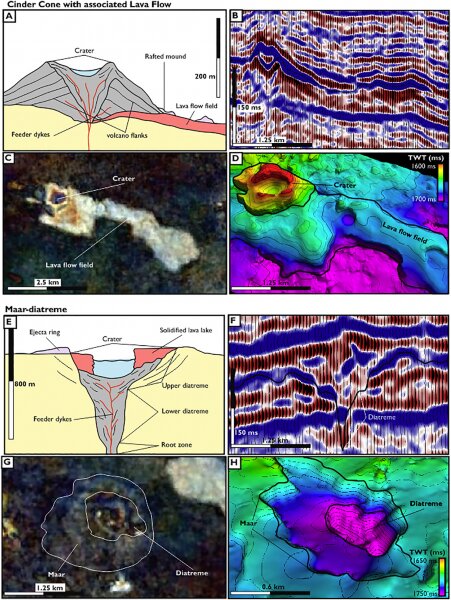A trove of 100 Jurassic-era volcanoes has been discovered deep underneath a petroleum-rich region of central Australia, according to a new study.
The ancient volcanoes formed between 180 and 160 million years ago, just as the prehistoric supercontinent Gondwana—of which Australia was once a part—began to break apart. For millennia, this underground volcanic landscape lay buried underground, eluding detection.
The subterranean range was detected in 2017 by a team of scientists led by geoscientist Jonathon Hardman, who was pursuing his PhD at the University of Aberdeen in Scotland at the time (he is now employed by the oil services company CGG). Hardman and his colleagues named the formation the Warnie Volcanic Province, and published their findings in the journal Gondwana Research.
The Warnie Volcanic Province is located more than a kilometer beneath the Cooper and Eromanga Basins, a region of dinosaur-aged sedimentary rock that spans more than 1 million square kilometers.

Imagery from the Gondwana Research paper. Image: University of Aberdeen/University of Adelaide
These deposits have been a hotspot of oil and gas production since the 1960s, and the region is currently Australia’s largest onshore source of hydrocarbons, which made the new find particularly surprising.
According to the study authors, finding such an epic volcanic landscape in an area that has already undergone substantial data collection “raises the prospect of other undiscovered [...] volcanic provinces both in Australia and in other continental areas worldwide.”
Some 1,400 oil wells have been drilled in this area over the past half-century, some of which turned up igneous rocks that suggested ancient lava might be preserved in the sediment.
To probe deep in the deposits, Hardman and his colleagues collected seismic, well, gravity, and magnetic data from the Nappamerri Trough inside the Cooper Basin. This enabled them to sketch out the outline of the Warnie Volcanic Province, which is formally named after the nearby Warnie East 1 exploration well and informally named in honor of Australian cricketer Shane Warne.
It’s not clear why these active volcanoes formed 180 million years ago, especially since they were not located above any continental plate borders during the Jurassic Period, which is what normally drives volcanism.
Hardman and his colleagues proposed a few possible explanations for the province’s formation, such as the presence of plumes or upwellings of molten rock in Earth’s mantle, which is a hot layer of our planet below the surface and crust. But the team emphasized that “more work needs to be conducted on the area before it can be concluded what the source of the Warnie Volcanic Province is.”
Regardless of the processes that formed it, it’s clear that the range had a major effect on its “Jurassic world,” in the words of study co-author Simon Holford of the University of Adelaide.
Long ago, these mountains belched lava and ash over the rivers and lakes surrounding them, before they, too, were ultimately submerged by eons worth of sediment.
https://www.vice.com/en_us/article/qvg4gb/scientists-found-a-hidden-jurassic-world-buried-underneath-australia
2019-08-14 14:23:27Z
CAIiENly1qgRna76WJUMpTr71rYqFwgEKg4IACoGCAowis8wMLmCBjCfkLEG
Bagikan Berita Ini














0 Response to "Scientists Found a Hidden 'Jurassic World' Buried Underneath Australia - VICE"
Post a Comment